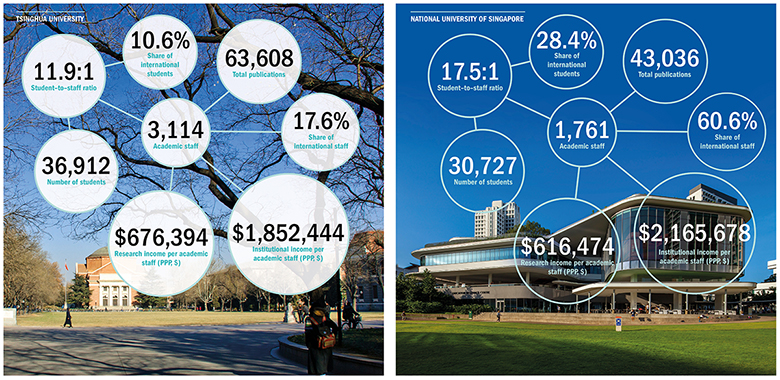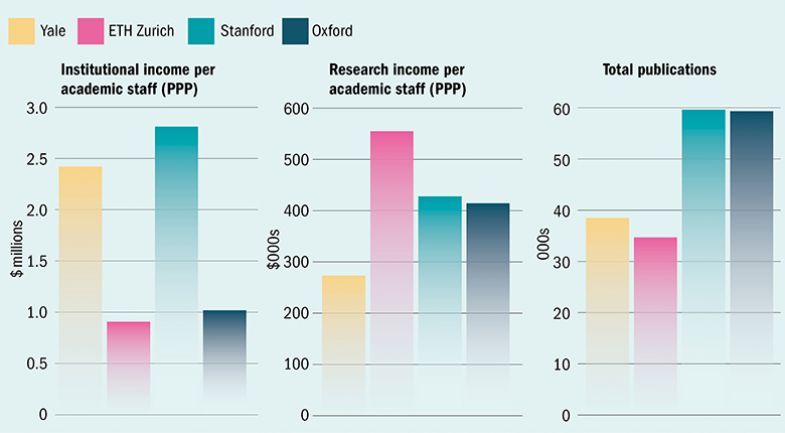Browse the full results of the World University Rankings 2019
If we are almost a fifth of the way into the Asian Century, then China is undoubtedly at the centre of the continent’s increasing global dominance.
Just look at the country’s higher education sector. In 2016, about 44 million students were enrolled in China’s universities and an estimated 6 million graduated from such institutions, according to data from the Unesco Institute for Statistics.
A recent analysis of trends in Elsevier’s Scopus database of scholarly research found that China’s rapidly improving performance on overall citation impact might see it match the US by the mid-2020s.
These developments are reflected in Times Higher Education ’s stable of rankings, with China’s leading universities soaring up the global and Asian tables and enhancing their international reputations.
This year is no exception to that trend. China has once again risen in the Times Higher Education World University Rankings, with a Chinese university becoming the top institution in Asia for the first time under the current rankings methodology.
Tsinghua University has overtaken the National University of Singapore as the best institution in the continent, after rising eight places to 22nd – representing the greatest rise in the top 30. NUS faced a minor drop from joint 22nd to 23rd.
THE World University Rankings 2019: results announced
The movement means that it is also the first time that Tsinghua is ranked above its Beijing neighbour Peking University in the global table, although Tsinghua overtook its rival in the 2018 Asia University Rankings in February and has consistently had higher scores in THE ’s annual reputation rankings.
Tsinghua’s rise was driven largely by improvements to its teaching environment, in particular increases in institutional income and the share of PhD degrees awarded. As a result, it is now ranked 11th in the teaching pillar, up from 16th last year (see page 102).
The university also improved its citation impact and has a more international outlook compared with last year, with greater shares of international staff, students and co-authored publications.
Meanwhile Peking dropped four places to 31st this year – its lowest position since 2016. While its overall score was the same as last year, it faced increasing competition and was overtaken by the University of California, San Diego as well as by Tsinghua. While Peking improved in the same teaching metrics as Tsinghua, it suffered declines in two of the financial measures – industry income and research income.
Yang Bin, vice-president for international affairs and provost at Tsinghua, attributes the institution’s strong performance to a new “global strategy” that began in 2015 to set the “university’s direction and priorities in the global context” as well as reforms to improve the quality of teaching and research, by better measuring the performance of faculty, for example.
The global strategy includes nine key objectives from introducing global curricula and recruiting a diverse student population to conducting research on issues of global impact and establishing a global reputation.
Another Chinese star in the world rankings is Zhejiang University, which has climbed a staggering 76 places to 101st this year, thanks to improvements in all five metrics underpinning the teaching pillar, as well as research income, research volume, industry income, proportion of international students and proportion of international staff.
A spokesman at Zhejiang says that the university has made “concerted efforts to promote synergy in research, education and industry collaboration to develop an innovative ecosystem and incentivise our faculty to tap into their potential”.
Like Tsinghua, Zhejiang’s performance also reflects the institution’s implementation of a new global strategy, “which envisions a more open and global university for all”, he says. Last year, Zhejiang opened a new international campus in Haining, where it hosts joint institutes with the University of Edinburgh and the University of Illinois at Urbana-Champaign.
“For now, the main challenge for us is to maintain this momentum, to find a balance between speed and quality. However, the interdisciplinary opportunities will offer a competitive advantage if we can think unconventionally and forge new connections,” the spokesman adds.
How Asia’s heavyweights compare

Overall, 72 Chinese universities make the 2019 ranking, up from 63 last year, and seven feature among the elite top 200. While some of China’s newcomers have joined as a result of an expansion of the table to include 1,258 universities, up from 1,103 last year (we only print 1,000), in most cases it reflects their strong performance.
For example, China’s highest-ranked new representative is the Southern University of Science and Technology (SUSTech) – in the 301-350 band – which opened in 2011 with the aim of quickly establishing itself as a world-class university. It is located in Shenzhen, which has been dubbed China’s Silicon Valley.
China’s success extends beyond the mainland. Five of Hong Kong’s six representatives have risen up the table this year, and five appear in the top 200 for the third year in a row despite increasing global competition.
Download a copy of the World University Rankings 2019 digital supplement
The University of Hong Kong is still the region’s flagship and has moved up four places to 36th, thanks to significant boosts in three metrics underpinning the teaching environment pillar, including institutional income and teaching reputation.
Ian Holliday, vice-president of teaching and learning at HKU, attributes this rise to a new “vision” to “purposely advance innovation, interdisciplinarity and internationalisation in convergence”.
“Innovation is pivotal in our teaching environment. In order to equip our graduates to tackle grand global challenges, we have invested in an enabling environment where creativity, experimentation and calculated risk-taking are prized and harnessed,” he says.
“We make full use of information technology to support our teaching and learning strategies with investments in campus facilities and e-learning, and now have a diverse range of classroom experiences for our students; we partner with innovative organisations to create opportunities for students to gain exposure to cutting-edge experience in both the commercial and non-commercial sectors; we empower students, whether individually or in groups, to design and implement their own innovative off-campus learning programmes; we also stimulate debate about everyday pedagogical innovation to encourage all our teachers to reanimate their courses.”
Looking ahead, the university hopes that every student will soon receive opportunities for “personal development, improved language skills and experience outside their comfort zone”, and it plans to “further embed social responsibility into our curriculum to ensure that our students can better serve society and meet its growing needs”, Holliday adds.
Elsewhere in Asia, Japan has overtaken the UK as the second most represented nation in the table with 103 universities, up from 89. Japan’s two leading institutions have both risen, with the University of Tokyo climbing four places to 42nd and Kyoto University jumping nine places to 65th.
South Korea’s front-runner – Seoul National University – has also climbed up the table, claiming 63rd place this year, up from joint 74th. Sungkyunkwan University joins the top 100 for the first time, after rising 29 places to joint 82nd, becoming South Korea’s second best institution.

However, while Asia has improved its standing, the Anglo-Saxon dominance at the top of the ranking has been cemented further this year as ETH Zurich – the only university outside the US and the UK in the top 10 – slips out of this elite group, dropping from joint 10th to 11th place.
The Swiss institution improved its overall score this year, so the decline is largely because of increased competition. The university was also held back by drops in several finance measures, including research income and industry income, while its citation impact score took a hit.
However, there is cause for celebration for other continental European universities, with two of France’s recent mergers featuring in the top 100.
Paris Sciences et Lettres – PSL Research University Paris, a 2010 merger of numerous institutions, which made its debut in the world rankings last year, has climbed an impressive 31 places to 41st, becoming the first French university to feature in the top 50 since 2011.
Its teaching and research scores shot up this year, driven by increased global visibility and votes in academic teaching and research reputation surveys.
Meanwhile, Sorbonne University, which was created in January by the merger of Pierre and Marie Curie University (a science and medicine-focused institution) and Paris-Sorbonne University (an arts and humanities university), makes its debut at 73rd place – making it the highest-ranked newcomer in the list.
Last year, Pierre and Marie Curie University was ranked joint 123rd and Paris-Sorbonne University – Paris 4 took 196th place, suggesting that the new institution is already reaping rewards as a result of the merger. The new Sorbonne, like its constituents, has a particularly strong citation impact, but data show that the merger has boosted the institution’s teaching and research environments. The merged university also achieves a high score for international research collaboration.
The University of Hamburg is another European success story, climbing from the 201-250 band to joint 135th. It received higher scores for institutional income, research volume, citation impact and industry income.
Hamburg’s president, Dieter Lenzen, says that the university is carrying out fundamental reforms, precipitated in part by recommendations from the German Council of Science and Humanities (Wissenschaftsrat) and proposal submissions to the country’s Excellence Strategy.
The reform process has been thorough: the institution has established working groups made up of internal and external experts for all 25 sub-strategies of the overall strategy, as well as 15 subject-based advisory groups.
“The reform of our university’s structures and processes – as yet work in progress – forms the basis for the optimisation of our performance. As a result, the University of Hamburg has emerged as the flagship university in northern Germany,” Lenzen says.
In southern Europe, Italy and Spain have also had a strong year. Italy’s three leading universities have all risen, including the University of Bologna, which now makes the top 200 at 180th place (up from the 201-250 band).
Spain’s two front-runners –Pompeu Fabra University and the Autonomous University of Barcelona – have also moved up, by five and two places, respectively. They are both in the global top 150.
Productivity measures compared

Despite these notable moves, the summit of the ranking is much more stable. The University of Oxford, the University of Cambridge and Stanford University retain the top three spots this year.
The Massachusetts Institute of Technology climbs just one place to fourth, while the California Institute of Technology, which led the ranking between 2012 and 2016, further loses its standing this year, dropping two places to fifth as its score on industry income and on other measures dipped.
But the biggest change is that Yale University joins the top 10 for the first time since 2015 after rising four places to eighth – representing the largest movement in the top 20 and Yale’s highest rank under the current methodology. It received higher scores for institutional income, research income, research volume, industry income and international staff this year.
Yale president Peter Salovey highlights several changes at the Ivy League institution that may account for its progress.
“Our recent facilities projects – building a new science building and a hub for the humanities, renovating teaching laboratories and art galleries, and creating new spaces for economics, innovation, and entrepreneurship initiatives – underscore Yale’s focus on supporting our faculty and students to address some of the most significant scientific, technological and social challenges of the day,” he says.
The university is also working hard to recruit and retain academics “who are both renowned investigators and dedicated educators” as well as build and strengthen international collaborations, he adds.
The University of Texas at Austin has also boosted its performance, leaping 10 places to join the top 40 at 39th place, registering significant increases in its institutional income and research volume.
Maurie McInnis, the institution’s executive vice-president and provost, says that recent investments in faculty compensation and interdisciplinary research and the addition of a new medical school are enhancing its research impact.
“By placing greater emphasis on doctoral programmes and strategic hiring, the university aims to become even stronger in years to come,” she says.
The US is still the most represented country in the rankings, claiming 172 places overall, up from 157 last year. But while an impressive 60 make the top 200, three institutions have fallen out of this elite group and only one has joined it.
Across the border in the Great White North, universities are faring better, with three Canadian institutions (the University of Ottawa, Western University and the University of Calgary) rising to join the top 200 this year.
The University of Montreal also features in the top 100 for the first time since 2013 after rising 18 places to joint 90th, off the back of improved scores for institutional income, research volume, citation impact and industry income.
Rector Guy Breton says that the Quebec institution’s reputation has been “growing in leaps and bounds over the past few years”.
“In the computer science and artificial intelligence sectors, for instance, our expertise has reached a truly global audience. Indeed, the exceptional work of Yoshua Bengio, Gilles Brassard and many other professors demonstrates that we have the know-how and the drive to innovate across a wide variety of fields, reflecting the talent and passion of our entire community,” he says.
Shifting landscape
This map shows the distribution of universities in the ranking, with the colour representing institutions’ change in score since last year. The translucent circles are the new entries in 2019

Editor’s note: November 2018
This article previously stated that four universities in Hong Kong have risen up the World University Rankings. Following a correction to the table on 22 November 2018, five universities in Hong Kong improved their rank. This has been amended in the article. For the most up-to-date 2019 World University Rankings results, always use the overall league table. Click here for more information.




